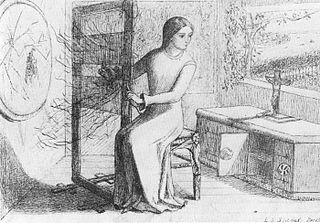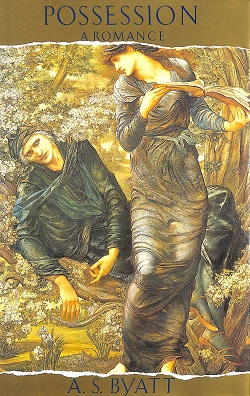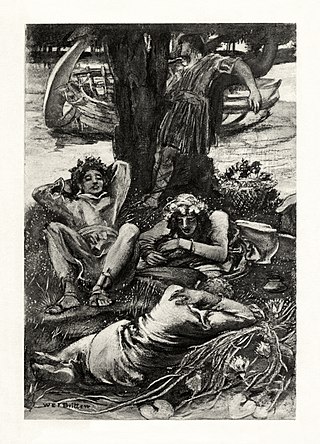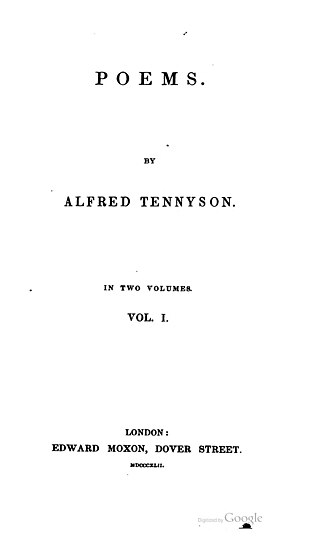
Alfred Tennyson, 1st Baron Tennyson was an English poet. He was the Poet Laureate during much of Queen Victoria's reign. In 1829, Tennyson was awarded the Chancellor's Gold Medal at Cambridge for one of his first pieces, "Timbuktu". He published his first solo collection of poems, Poems, Chiefly Lyrical, in 1830. "Claribel" and "Mariana", which remain some of Tennyson's most celebrated poems, were included in this volume. Although described by some critics as overly sentimental, his verse soon proved popular and brought Tennyson to the attention of well-known writers of the day, including Samuel Taylor Coleridge. Tennyson's early poetry, with its medievalism and powerful visual imagery, was a major influence on the Pre-Raphaelite Brotherhood.

Michael William Balfe was an Irish composer, best remembered for his operas, especially The Bohemian Girl.

"Ulysses" is a poem in blank verse by the Victorian poet Alfred, Lord Tennyson (1809–1892), written in 1833 and published in 1842 in his well-received second volume of poetry. An oft-quoted poem, it is a popular example of the dramatic monologue. Facing old age, mythical hero Ulysses describes his discontent and restlessness upon returning to his kingdom, Ithaca, after his far-ranging travels. Despite his reunion with his wife Penelope and his son Telemachus, Ulysses yearns to explore again.

"The Lady of Shalott" is a lyrical ballad by the 19th-century English poet Alfred Tennyson and one of his best-known works. Inspired by the 13th-century Italian short prose text Donna di Scalotta, the poem tells the tragic story of Elaine of Astolat, a young noblewoman stranded in a tower up the river from Camelot. Tennyson wrote two versions of the poem, one published in 1832, of 20 stanzas, the other in 1842, of 19 stanzas, and returned to the story in "Lancelot and Elaine". The vivid medieval romanticism and enigmatic symbolism of "The Lady of Shalott" inspired many painters, especially the Pre-Raphaelites and their followers, as well as other authors and artists.

The poem "In Memoriam A.H.H." (1850) by Alfred, Lord Tennyson, is an elegy for his Cambridge friend Arthur Henry Hallam, who died of cerebral haemorrhage at the age of twenty-two years, in Vienna in 1833. As a sustained exercise in tetrametric lyrical verse, Tennyson's poetical reflections extend beyond the meaning of the death of Hallam, thus, “In Memoriam” also explores the random cruelty of Nature seen from the conflicting perspectives of materialist science and declining Christian faith in the Victorian Era (1837–1901), the poem thus is an elegy, a requiem, and a dirge for a friend, a time, and a place.

Possession: A Romance is a 1990 best-selling novel by British writer A. S. Byatt that won the 1990 Booker Prize for Fiction. The novel explores the postmodern concerns of similar novels, which are often categorised as historiographic metafiction, a genre that blends approaches from both historical fiction and metafiction.

"The Charge of the Light Brigade" is an 1854 narrative poem by Alfred, Lord Tennyson about the Charge of the Light Brigade at the Battle of Balaclava during the Crimean War. He wrote the original version on 2 December 1854, and it was published on 9 December 1854 in The Examiner. He was the Poet Laureate of the United Kingdom at the time. The poem was subsequently revised and expanded for inclusion in Maud and Other Poems (1855).
"The Last of the Light Brigade" is a poem written in 1890 by Rudyard Kipling echoing – thirty-six years after the event – Alfred Tennyson's famous poem The Charge of the Light Brigade. Employing synecdoche, Kipling uses his poem to expose the terrible hardship faced in old age by veterans of the Crimean War, as exemplified by the cavalry men of the light brigade who charged at the Battle of Balaclava. It describes a visit by the last twenty survivors of the charge to Tennyson to reproach him gently for not writing a sequel about the way in which England was treating its old soldiers. Some sources treat the poem as an account of a real event, but other commentators class the destitute old soldiers as allegorical, with the visit invented by Kipling to draw attention to the poverty in which the real survivors were living, in the same way that he evoked Tommy Atkins in "The Absent Minded Beggar".

"Locksley Hall" is a poem written by Alfred Tennyson in 1835 and published in his 1842 collection of Poems. It narrates the emotions of a rejected suitor upon coming to his childhood home, an apparently fictional Locksley Hall, though in fact Tennyson was a guest of the Arundel family in their stately home named Loxley Hall, in Staffordshire, where he spent much of his time writing whilst on his visits.
"Crossing the Bar" is an 1889 poem by Alfred, Lord Tennyson. It is considered that Tennyson wrote it in elegy; the narrator uses an extended metaphor to compare death with crossing the "sandbar" between the river of life, with its outgoing "flood", and the ocean that lies beyond death, the "boundless deep", to which we return.
Nationality words link to articles with information on the nation's poetry or literature.

"The Two Voices" is a poem written by future Poet Laureate of the United Kingdom Alfred, Lord Tennyson between 1833 and 1834. It was included in his 1842 collection of Poems. Tennyson wrote the poem, titled "Thoughts of a Suicide" in manuscript, after the death of his friend Arthur Henry Hallam in 1833. The poem was autobiographical.

"Tears, Idle Tears" is a lyric poem written in 1847 by Alfred, Lord Tennyson (1809–1892), the Victorian-era English poet. Published as one of the "songs" in his The Princess (1847), it is regarded for the quality of its lyrics. A Tennyson anthology describes the poem as "one of the most Virgilian of Tennyson's poems and perhaps his most famous lyric". Readers often overlook the poem's blank verse—the poem does not rhyme.

Mariana is an 1851 oil-on-panel painting by John Everett Millais. The image depicts the solitary Mariana from William Shakespeare's Measure for Measure, as retold in Tennyson's 1830 poem "Mariana". The painting is regarded as an example of Millais's "precision, attention to detail, and stellar ability as a colorist". It has been held by Tate Britain since 1999.

"Tithonus" is a poem by the Victorian poet Alfred, Lord Tennyson (1809–92), originally written in 1833 as "Tithon" and completed in 1859. It first appeared in the February edition of the Cornhill Magazine in 1860. Faced with old age, Tithonus, weary of his immortality, yearns for death. The poem is a dramatic monologue with Tithonus addressing his consort Eos, the goddess of the dawn.

The Princess is a serio-comic blank verse narrative poem, written by Alfred Tennyson, published in 1847. Tennyson was Poet Laureate of the United Kingdom from 1850 to 1892 and remains one of the most popular English poets.

"Mariana" is a poem by Alfred, Lord Tennyson, published in 1830. The poem follows a common theme in much of Tennyson's work—that of despondent isolation. The subject of "Mariana" is a woman who continuously laments her lack of connection with society. The isolation defines her existence, and her longing for a connection leaves her wishing for death at the end of every stanza. The premise of "Mariana" originates in William Shakespeare's Measure for Measure, but the poem ends before Mariana's lover returns. Tennyson's version was adapted by others, including John Everett Millais and Elizabeth Gaskell, for use in their own works. The poem was well received by critics, and it is described by critics as an example of Tennyson's skill at poetry.

"The Deserted House" is a poem written by Alfred Lord Tennyson in 1830, as part of his collection Poems, Chiefly Lyrical. The poem is characterised by its reliance on short lines which alternate in rhyme and meter to prevent a felicitous feel. In the poem, Tennyson uses the image of a dark house as a metaphor for a dead body

The Lotos-Eaters is a poem by Alfred Tennyson, 1st Baron Tennyson, published in Tennyson's 1832 poetry collection. It was inspired by his trip to Spain with his close friend Arthur Hallam, where they visited the Pyrenees mountains. The poem describes a group of mariners who, upon eating the lotos, are put into an altered state and isolated from the outside world. The title and concept derives from the lotus-eaters in Greek mythology.

Poems, by Alfred Tennyson, was a two-volume 1842 collection in which new poems and reworked older ones were printed in separate volumes. It includes some of Tennyson's finest and best-loved poems, such as Mariana, The Lady of Shalott, The Palace of Art, The Lotos Eaters, Ulysses, Locksley Hall, The Two Voices, Sir Galahad, and Break, Break, Break. It helped to establish his reputation as one of the greatest poets of his time.

















